Google Sets a Time of 1 Second to Render a Mobile Website
Google Sets a Time of 1 Second to Render a Mobile Website

Usually we use pagespeed insight to analyze the speed of our website. Whether it's for desktop display or for mobile display. Especially for mobile displays, pagespeed will provide recommendations to make a page can be rendered in less than 1 second.
This is an important process for those of you who are just learning SEO, because if our website fails to meet these deadlines, then SEO optimization that we do can be more severe.
Why does Google implement this? He said their research shows that just a 1 second delay can make Google mobile users change their minds and give a bad user experience.
Google aims to keep users interacting with the web pages provided and satisfied with the search results, whatever the results are and whatever the network connection is.
Meet the 1 Second Standard

Usually we use pagespeed insight to analyze the speed of our website. Whether it's for desktop display or for mobile display. Especially for mobile displays, pagespeed will provide recommendations to make a page can be rendered in less than 1 second.
This is an important process for those of you who are just learning SEO, because if our website fails to meet these deadlines, then SEO optimization that we do can be more severe.
Why does Google implement this? He said their research shows that just a 1 second delay can make Google mobile users change their minds and give a bad user experience.
Google aims to keep users interacting with the web pages provided and satisfied with the search results, whatever the results are and whatever the network connection is.
Meet the 1 Second Standard
Obviously it is not easy to meet this standard. Fortunately not all pages must be loaded in 1 second. Google targets the page that first appears on the screen, or content above the fold that must be loaded in less than 1 second. The rest can be loaded in the background ...
But the problem is Google is also targeting "whatever the network connection" ... and this is difficult. What if someone online uses a 2G connection? Yes, of course, the most common connection today is 4G, but 2G ... especially 3G is still quite a lot of users.
In this case, Google only takes into account 4G users. So Google assumes that the request sent to the network will take 0.1 seconds from the availability of 1 second to load the content above the fold.
So if you look at the connection from the browser to the server, there will be around 0.3 seconds needed to complete the host name into the IP address by the DNS lookup; network travel to do TCP handshakes; and an alternative TLS connection ...
So from here we have 0.7 seconds to make our website display the contents of the home screen ...
Which must be done
To make the initial appearance of your website can be loaded in less than 1 second, then there are several things that you need to pay attention to, namely:
There are still a few more things you can use to reduce the time needed to render, but you can try the 4 things above. Of course for most people this is not an easy thing.
If you don't know how to make a lightweight website for mobile connections; You can ask for help with website creation services to edit your website. Currently there are many who provide this website creation services.
In the future, SEO competition will be even harder, and more things will be demanded from your website. So it doesn't hurt you to learn the basics of web design from now on.
- Reducing Server Response Time is less than 0.2 seconds
- Avoid redirects in page loading
- The amount of data sent in the first rendering must be minimized. Because TCP must estimate the capacity of a connection, a TCP connection cannot directly use all of the bandwidth available between the client and the server.
- The server can send up to 10 TCP packets or around 14KB in initial data sending to start a new connection. Because of this TCP behavior, it is very important to minimize the content so that the data travel for initial rendering can be less.
- Avoid javascript or external CSS that prevents rendering the initial content of the page when you create a website. Before the browser can render a page; The browser must parse the web page. If the browser finds a script that is not async, the browser must stop first to download this script. So at least to make it easy for early renders to use inline javascript and CSS.
There are still a few more things you can use to reduce the time needed to render, but you can try the 4 things above. Of course for most people this is not an easy thing.
If you don't know how to make a lightweight website for mobile connections; You can ask for help with website creation services to edit your website. Currently there are many who provide this website creation services.
In the future, SEO competition will be even harder, and more things will be demanded from your website. So it doesn't hurt you to learn the basics of web design from now on.
0 Response to "Google Sets a Time of 1 Second to Render a Mobile Website"
Post a Comment